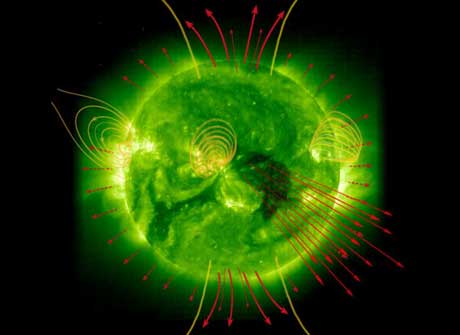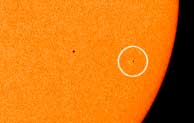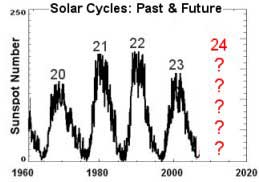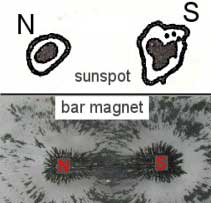2006 08 17
From: science.nasa.gov

On July 31st, a tiny sunspot was born. It popped up from the sun's interior, floated around a bit, and vanished again in a few hours. On the sun this sort of thing happens all the time and, ordinarily, it wouldn't be worth mentioning. But this sunspot was special: It was backward.

The tiny, backward sunspot of July 31, 2006. Credit: SOHO. [Larger image] |
"We've been waiting for this," says David Hathaway, a solar physicist at the Marshall Space Flight in Huntsville, Alabama. "A backward sunspot is a sign that the next solar cycle is beginning."
"Backward" means magnetically backward. Hathaway explains:
Sunspots are planet-sized magnets created by the sun's inner magnetic dynamo. Like all magnets in the Universe, sunspots have north (N) and south (S) magnetic poles. The sunspot of July 31st popped up at solar longitude 65o W, latitude 13o S. Sunspots in that area are normally oriented N-S. The newcomer, however, was S-N, opposite the norm.
A picture is worth a 1000 words. In the magnetic map of the sun, below, N is white and S is black. The backward sunspot is circled:

Above: A SOHO magnetogram of the sun. July 31, 2006.
This tiny spot of backwardness matters because of what it might foretell: A really big solar cycle.
Solar activity rises and falls in 11-year cycles, swinging back and forth between times of quiet and storminess. Right now the sun is quiet. "We're near the end of Solar Cycle 23, which peaked way back in 2001," explains Hathaway. The next cycle, Solar Cycle 24, should begin "any time now," returning the sun to a stormy state.
Satellite operators and NASA mission planners are bracing for this next solar cycle because it is expected to be exceptionally stormy, perhaps the stormiest in decades. Sunspots and solar flares will return in abundance, producing bright auroras on Earth and dangerous proton storms in space: full story.
 But when will Solar Cycle 24 begin?
But when will Solar Cycle 24 begin?
"Maybe it already did--on July 31st," says Hathaway. The first spot of a new solar cycle is always backwards. Solar physicists have long known that sunspot magnetic fields reverse polarity from cycle to cycle. N-S becomes S-N and vice versa. "The backward sunspot may be the first sunspot of Cycle 24."
It sounds exciting, but Hathaway is cautious on several fronts:
First, the sunspot lasted only three hours. Typically, sunspots last days, weeks or even months. Three hours is fleeting in the extreme. "It came and went so fast, it was not given an official sunspot number," says Hathaway. The astronomers who number sunspots didn't think it worthy!
Second, the latitude of the spot is suspicious. New-cycle sunspots almost always pop up at mid-latitudes, around 30o N or 30o S. The backward sunspot popped up at 13o S. "That's strange."
These odd-isms stop Hathaway short of declaring the onset of a new solar cycle. "But it looks promising," he says.
Even if Cycle 24 has truly begun, "don't expect any great storms right away." Solar cycles last 11 years and take time to build up to fever pitch. For a while, perhaps one or two years, Cycle 23 and Cycle 24 will actually share the sun, making it a hodgepodge of backward and forward spots. Eventually, Cycle 24 will take over completely; then the fireworks will really begin.
Meanwhile, Hathaway plans to keep an eye out for more backward sunspots.
More to the story...
In the story, above, we explain that the July 31st sunspot popped up with a magnetic polarity opposite its neighbors. That's what made it "backwards." But there's more to the story....

Sunspots, like bar magnets, have north and south magnetic poles. |
On the sun, there is a grand pattern of sunspot polarities. In the sun's northern hemisphere, all spots are S-N. In the southern hemisphere, all spots are N-S. This is how it has been for the past 10+ years during Solar Cycle 23. When Cycle 24 arrives, the grand pattern will flip. Northern sunspots will become N-S while southern sunspots will become S-N. This flipping action occurs every time one cycle gives way to another; it's part of Hale's Law.
The July 31st sunspot, with its S-N orientation, would have fit right in if it had popped up in the sun's northern hemisphere. All the spots around it would've been S-N, too. Instead, it emerged in the southern hemisphere where N-S has held sway for a decade. This made it backwards and a harbinger of the next solar cycle.
Trivia: The coordinates of the July 31st sunspot were 65 W, 13 S. It if had popped up at those coordinates on Earth, it would have been in Bolivia, making it a "South American" sunspot.
Solar Storm Warning (Science@NASA) -- Researchers from the University of Colorado believe the next solar cycle (Solar Cycle 24) will be the most intense in 50 years.
The Vision for Space Exploration
Article from: http://science.nasa.gov/headlines/y2006/15aug_backwards.htm?list109322
Signs of Horrific New Solar Cycle to Begin
By Mitch Battros - ECM/ECTV
On July 31st, a small sunspot was viewed and recorded. This finding which shows the first sunspot in ‘magnetic reverse’, suggest the ushering in of a new solar cycle. This one would be “Cycle 24”. Solar physicists have known that sunspot magnetic fields reverse polarity from cycle to cycle. North becomes South and South becomes North.
David Hathaway, a solar physicist at the Marshall Space Flight in Huntsville, Alabama states "A backward sunspot is a sign that the next solar cycle is beginning." The term ‘backwards’ as used by Hathaway means the magnetic lay-lines of a sunspot(s) have reversed.
As heard “live” on the ECM/ECTV “Radio Hour”, Dr. Mausumi Dikpati research scientist at the National Center for Atmospheric Research in Boulder, Colorado disclosed for the first time on national and international air-waves, “Cycle 24 will be up to 50% stronger than the current cycle (Cycle 23)”. Cycle 23 delivered the largest solar flare ‘ever recorded’. The November 4th 2003 solar flare was estimated to be an X-45. Up until this time, all measuring instruments stopped at X-9.
Dr. Dikpati Interview: http://www.earthchangestv.com/secure/2004/article_12487.php
Sunspots are planet-sized magnets created by the Sun's inner magnetic dynamo. Like all magnets in the Universe, sunspots have north (N) and south (S) magnetic poles. The sunspot of July 31st popped up at solar longitude 65o W, latitude 13o S. sunspots in that area are normally oriented N-S. The newcomer, however, was S-N, opposite the norm.
Scientists are still debating if this latest sunspot reversal is in fact the tale-tell sign a new cycle has begun. As we know, sunspots last several days and often survive passing through the ‘far-side’ of the Sun giving the sunspot a longer life which could last a month or more. This July 31st event only lasted three hours giving some researchers a “wait-and-see” posture.
The revving up of this new solar cycle will take several months to begin to show its true power. The “apex” or ‘maximum’ should be towards the end of 2011-2012. Yes folks, the maximum power which indicates Cycle 24’s most damaging period lands right smack in the middle of Mayan prophecy. This will certainly be quite interesting. That is---if we don’t nuke ourselves right out of existence before then.
Article from: ECTV Newsletter
Related: Sun's next 11-year cycle could be 50% stronger
Active Sun Throws NASA Predictions Off
Sunspot Cycles & Natural Disasters
Has The Magnetic Pole Reversal Already Begun? South Atlantic Anomaly Could be First Evidence - Part I | Part 2 | Part 3
Scientists Reconstructed the Sun's Activity Over the Last 11 Millennia
Sunspots reaching 1,000-year high
